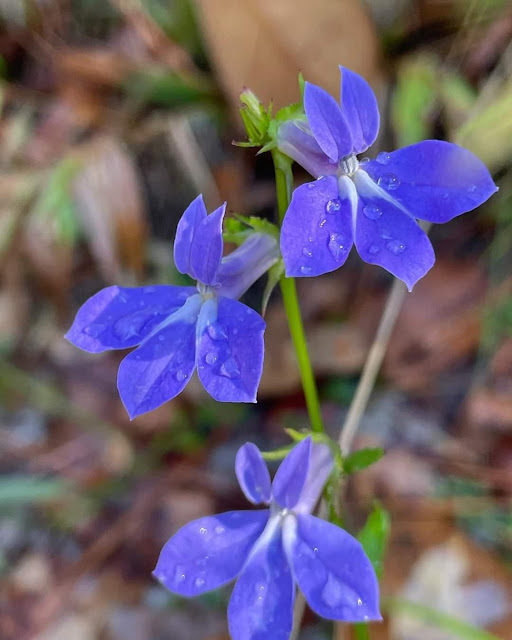 |
| Flowers |
 |
| Foliage in situ |
This is a blog that celebrates the beauty and diversity of Florida's wildflowers - with a bit of a focus on growing these plants in a home landscape. Some of the wildflowers featured here are grown and sold through Hawthorn Hill Native Wildflower and Rare Plant Nursery. E-mail (Huegelc55@aol.com)or call me (727-422-6583) if there is something you want to see in this blog - or something you wish to purchase.
 |
| Flowers |
 |
| Foliage in situ |
Striped gentian (Gentiana villosa) is Florida's most unique member of this beloved genus - having white to very pale blue striped flowers instead of the usual deep blue ones. It is found in seven Panhandle counties in extreme north Florida, but is found in much of the Southeast Coastal Plain from Louisiana to Virginia and Maryland. Throughout its range, it is most often encountered in open woodlands.
Although its Latin species name means "hairy", the foliage is decidedly glabrous. The leaves are lanceolate but are typically wider above the middle of the leaf. The leaves are dark green and shiny. like other members of this genus, it is a perennial that dies back to the ground each winter and emerges again in early spring. Mature plants can reach 2 feet in height. The flowers buds are clustered at the top of the plant. Striped gentian typically blooms during the fall in late August to October. The flowers are pollinated mostly by bees that are attracted to their stripes and nectar. The seed capsules ripen during October to November. The seeds of G. villosa differ from other gentians because they are wingless.
Gentians have long been used medicinally by herbalists. As one of its common names suggest (Sampson's snakeroot), striped gentian is thought to aid in the relief of snakebites. In Appalachia, its roots are carried as a charm. The Catawba Indians used the boiled roots as medicine to relieve back pain.
Despite the charm and utility of gentians, few are ever offered commercially and none are available from nurseries affiliated with FANN - the Florida Association of Native Nurseries. This is regrettable and so this species and its relatives must solely be admired when encountered in the fall when hiking in their preferred habitat. Do not be tempted to collect it.
These photos were taken by Helen Roth and used by permission.
The leaves are simple and nearly linear, alternate along the stem and are without the "hairs" found in many other species such as L. savannensis and L. gracilis. The simple flowering stalk reaches its mature height of about 3 feet by August and the blooms open from the top of the stalk downwards for the next 2-3 weeks. The flower buds are sessile (without a stalk) and are slightly hairy. Like most members of this genus, the flowers are lavender and attract the attention of a great diversity of pollinators.
Florida is home to 19 species of blazing stars, but only a few are grown commercially by native plant nurseries affiliated with FANN - the Florida Association of Native Nurseries. Grassleaf blazing star is one of the many that I have not seen offered. Blazing stars are easy to propagate from mature seed collected in late fall and sown immediately just below the soil surface in flats. As all blazing stars are beautiful additions to a pollinator garden, more species, like this one, should be made available in the future.
These photos were taken by my friend, Lily Byrd, and shared by permission.